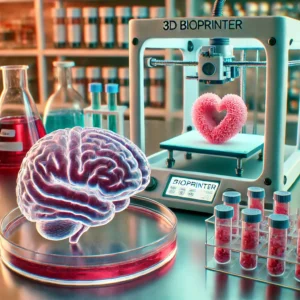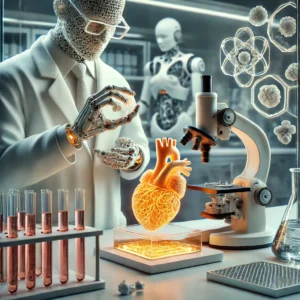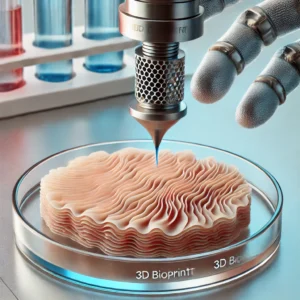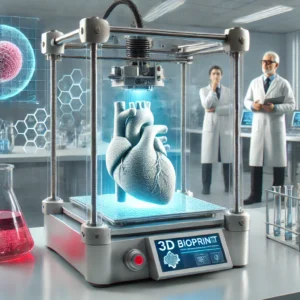Advantages of 3D Bioprinting: Transforming Healthcare, Environment, and Industry

3D bioprinting, a highly innovative form of additive manufacturing, is redefining industries from healthcare and pharmaceutical research to environmental science and food technology. Leveraging bio-ink made from live cells and biocompatible materials, this technology allows the fabrication of complex, three-dimensional biological structures. The benefits of 3D bioprinting extend across multiple domains, from customized organ transplants to sustainable food production, all while offering ethical and eco-friendly alternatives to traditional processes. In this article, we delve into the substantial advantages of 3D bioprinting and its transformative role in shaping the future.
What is 3D Bioprinting?
3D bioprinting is an additive manufacturing process that creates biological structures layer by layer using bio-inks composed of cells, growth factors, and other bio-compatible materials. Unlike standard 3D printing, which uses materials like plastics and metals, bioprinting uses biological substances to replicate tissues and, ultimately, functional organs. Initially developed as an experiment, 3D bioprinting is now recognized as a viable and groundbreaking technology that can address various limitations in medicine, environmental conservation, and food production.
The Process of 3D Bioprinting
The 3D bioprinting process starts with a digital model of the desired biological structure. The design is then converted into a series of instructions for a 3D bioprinter, which deposits layers of bio-ink to build the structure. This precision-guided process allows for the recreation of complex shapes and forms, replicating natural tissue layers in remarkable detail.
To enhance the compatibility and functionality of bioprinted tissues, researchers use bio-compatible scaffolds or support materials. These scaffolds are designed to degrade naturally over time, leaving only the bioprinted cells and tissues in their intended form. The process allows for extreme precision, enabling the creation of custom tissues and organs that cater to individual patient needs, a remarkable shift towards patient-specific healthcare solutions.
Key Advantages of 3D Bioprinting
1. Organ and Tissue Engineering
The most well-known and promising application of 3D bioprinting is in organ and tissue engineering. Traditionally, organ transplants rely on donors, which presents challenges like limited availability and tissue rejection. Bioprinting has the potential to mitigate these issues by creating functional organs and tissues in a lab environment, providing a sustainable alternative to traditional transplant processes.
- Reduced Organ Shortages: With 3D bioprinting, researchers are moving closer to producing functional organs like kidneys, hearts, and livers. These lab-grown organs, generated from a patient’s cells, eliminate the need for organ donors, potentially solving the global organ shortage crisis.
- Lowered Risk of Organ Rejection: Bioprinted organs can be developed using the patient’s cells, reducing the likelihood of immune system rejection. This patient-specific approach minimizes post-operative complications and can lead to higher success rates in organ transplants.
- Enhanced Recovery and Customization: 3D bioprinting also enables the customization of tissues and organs tailored to the patient’s anatomy. This tailored approach improves compatibility and recovery times, offering a personalized healthcare solution that traditional transplants lack.
2. Personalized Medicine
Personalized medicine, which tailors medical treatments to individual patient characteristics, is one of the most revolutionary aspects of modern healthcare. 3D bioprinting has made significant contributions to personalized medicine by enabling the creation of patient-specific tissues, organs, and drug therapies.
- Patient-Specific Tissues and Organs: Bioprinting allows for tissues that are tailored to the patient’s unique cellular makeup, reducing the risk of adverse reactions and improving overall treatment outcomes. For instance, bioprinted skin grafts created from a patient’s cells can match the body’s exact requirements, ensuring higher acceptance and faster healing.
- Improved Drug Testing and Dosage Precision: With 3D bioprinting, researchers can test new drugs on tissues engineered to replicate patient-specific characteristics. This patient-specific testing leads to more accurate data, reducing the trial-and-error approach to prescribing drugs.
- Cost-Efficiency in Treatment: Personalized treatment options made possible by 3D bioprinting may also reduce the costs associated with hospital stays, additional surgeries, or complications, making advanced care more affordable in the long run.
3. Advanced Pharmaceutical Testing
Bioprinted tissues offer an ethical and more accurate alternative for pharmaceutical testing. Testing on animal models has limitations as they may not accurately represent human reactions. With bioprinting, pharmaceutical companies can develop human tissue models to test drugs, allowing for more reliable results.
- Ethical Considerations and Reduced Animal Testing: 3D bioprinting enables the creation of human-like tissues, reducing the reliance on animal models for drug testing. As a result, it offers a more humane, ethically sound solution.
- Improved Accuracy in Drug Interactions: Bioprinted tissues closely mimic human responses, providing researchers with more accurate data. This advantage accelerates drug approval processes and enhances the safety and efficacy of new treatments.
- Accelerated Research and Development: By reducing dependency on animal testing and creating reproducible human tissue models, bioprinting shortens the drug development timeline. Consequently, pharmaceutical companies can bring new medications to market faster, addressing urgent medical needs more efficiently.
4. Environmental Applications: Bioremediation
3D bioprinting’s environmental applications include creating biofilms that host microorganisms capable of breaking down pollutants and toxic substances, a process known as bioremediation. With 3D bioprinted structures, scientists can develop sustainable and eco-friendly solutions for environmental cleanup.
- Eco-Friendly Pollution Cleanup: 3D bioprinted biofilms containing bacteria and other microorganisms can break down harmful substances like oil spills, plastic waste, and heavy metals. This method offers a sustainable approach to waste management and environmental restoration.
- Customizable Bioremediation Solutions: 3D bioprinting enables customization based on the type and extent of pollution. Scientists can design biofilms tailored to degrade specific contaminants, making bioremediation more efficient and targeted.
- Reduced Need for Chemical Intervention: By using living organisms to clean up pollutants, 3D bioprinting reduces the need for harmful chemicals in pollution management, resulting in a lower environmental footprint and a more sustainable approach to restoration.
5. Food Technology: Sustainable Cultured Meat Production
The food industry is exploring 3D bioprinting for its potential to revolutionize meat production. Cultured meat, grown from cells in a lab, offers an ethical and environmentally friendly alternative to traditional meat production.
- Reduced Environmental Impact: Traditional livestock farming has significant environmental consequences, including greenhouse gas emissions, deforestation, and water consumption. Bioprinted cultured meat offers a sustainable alternative, as it requires fewer resources and emits fewer pollutants.
- Ethical Meat Production: Bioprinting cultured meat eliminates the need for animal slaughter, aligning with ethical and environmental concerns. This process provides meat with textures and flavors comparable to traditional products.
- Customized Food Products: With 3D bioprinting, food can be customized for specific nutritional requirements, including meat products that are lower in fat or contain additional vitamins and minerals. This approach caters to diverse dietary preferences and health needs.
3D Bioprinting in Healthcare: A Closer Look at Specific Applications
1. Burn Treatment and Skin Regeneration
For burn victims, 3D bioprinting has become a powerful tool for developing personalized skin grafts. By printing skin with a patient’s cells, healthcare providers can create skin grafts that precisely match the patient’s own biological makeup.
- Customized Skin Grafts: Traditional skin grafts often face issues with rejection or scarring, but bioprinted skin, made from the patient’s own cells, offers better compatibility and aesthetic results.
- Enhanced Healing and Reduced Scarring: Bioprinted skin grafts align with natural healing processes, accelerating recovery and reducing the potential for scarring. This advancement is especially significant for burn victims who require extensive reconstructive surgery.
2. Joint and Cartilage Repair
Joint and cartilage damage is a common issue, especially among aging populations and athletes. Traditional joint replacements often face limitations in terms of durability and compatibility. 3D bioprinting offers an innovative solution by creating cartilage replacements tailored to each patient.
- Patient-Specific Cartilage for Enhanced Comfort: 3D bioprinting can produce cartilage that matches a patient’s joint structure, enhancing comfort and reducing the likelihood of rejection.
- Reduced Risk of Complications: Bioprinted cartilage, developed from the patient’s cells, poses fewer risks of immune rejection, resulting in improved joint function and faster recovery times.
- Longer-Lasting Solutions: Custom bioprinted cartilage is designed to mimic the patient’s natural cartilage, offering a more durable and effective solution than traditional joint replacements.
Pros and Cons of 3D Bioprinting Technology
3D bioprinting has both advantages and challenges as an emerging technology:
Pros:
- Customization: Offers personalized treatments and custom tissue implants tailored to individual needs.
- Ethical Drug Testing: Reduces reliance on animal testing by enabling human-tissue models for drug trials.
- Reduced Organ Shortages: Presents a potential solution for the growing need for organ transplants.
- Environmental Sustainability: Provides eco-friendly options for bioremediation and food production.
Cons:
- High Cost: 3D bioprinting technology remains costly, with barriers to widespread accessibility.
- Ethical Concerns: Manipulating human cells raises ethical questions in some sectors.
- Technical Limitations: Creating complex, fully functional organs remains an ongoing challenge that requires further scientific innovation.
The Future of 3D Bioprinting in Healthcare and Beyond
The future of 3D bioprinting is bright, with numerous possibilities emerging in healthcare and other fields. As researchers and scientists continue to develop the technology, the potential applications expand across regenerative medicine, pharmaceutical testing, environmental restoration, and food production. Here’s a look at what lies ahead:
- Breakthroughs in Artificial Organ Creation: Advances in bioprinting are paving the way for fully functional artificial organs, which could significantly reduce reliance on donors and improve patient outcomes.
- Expanded Use in Personalized Medicine: The ability to create patient-specific tissues and organs will enhance personalized medicine, making treatments more precise and effective.
- More Affordable and Accessible Technology: As 3D bioprinting becomes more widely adopted, its costs are expected to decrease, making it accessible to more healthcare facilities and research institutions.
- Sustainable Food Solutions for a Growing Population: With the rise in population, demand for sustainable food solutions is increasing. Bioprinting provides an eco-friendly way to produce food without the environmental drawbacks of traditional livestock farming.
3D bioprinting is reshaping industries, providing solutions to challenges that were once deemed insurmountable. Its contributions to personalized medicine, pharmaceutical testing, environmental cleanup, and sustainable food production mark a new era of ethical, eco-friendly advancements. While hurdles remain in terms of cost, technical complexity, and ethical considerations, the potential for this technology to solve global challenges is profound.
Visit our other website: https://synergypublish.com







